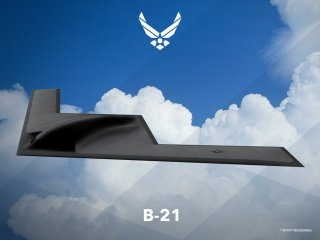Bombers for Days: The B-21 Won’t Replace Other Bombers for Awhile
While the Air Force’s stated goal for its emerging fleet of B-21s is to reach 100, will they arrive soon enough in sufficient numbers to fully sustain mission readiness across the bomber fleet?
Will the arrival of the new stealthy Air Force B-21 in large numbers in coming years mean a slow, steady sunset for existing B-2s, B-1B, and even B-52s?
Such a prospect, given the age and potential obsolescence of the current bomber fleet, raises a few interesting questions, for which the answers may be limited or at least unclear. While the Air Force’s stated goal for its emerging fleet of very promising B-21s is to reach 100, or possibly much much more, numbers of aircraft, will they arrive soon enough in sufficient numbers to fully sustain mission readiness more broadly across the bomber fleet?
There is an interesting and delicate balance to be achieved when it comes to sustaining and upgrading the existing fleet, while also designing, building, and introducing new platforms. The B-1B, for instance, is being upgraded to fly for more years into the future and potentially even carry hypersonic weapons. The B-2 is going through a sweeping overhaul to include new air-defense searching sensors, improved networking, faster computer processing and a new generation of weapons, among other things. Programs for these two legacy bombers are intended to bridge the gap between now and the point at which there are enough new B-21s. However, does the Air Force need another new bomber? A B-1B or B-52-like platform at some point? When? Of course, a pressing question with this would simply be... is there a budget?
Furthermore, there will of course also still be a need for heavier, larger B-52-like bombers able to travel with larger amounts of weapons and potentially even function as an “arsenal ship” of some kind launching and recovering unmanned systems and performing command and control. Will the B-52 remain technically viable to sustain modern, high-risk missions into the 2050s and beyond? That may in fact be the case. The B-52 is not only being re-engined but also equipped with a revamped internal weapons bay enabling greater ordnance carrying capacity and an entirely new generation of radio SatCom connectivity which can help pilot crews receive update targeting and intelligence data while in flight. Also, years ago Air Force platform and weapons developers voiced the view that technically speaking, the B-52 airframes were very strong, durable, and “viable” for decades to come, making it both possible and advantageous to add major networking and weapons upgrades. Many maintain that today’s emerging B-52 is essentially equivalent to a new, next-generation heavy bomber. Could the B-52 wind up flying for close to 100 years?
Nonetheless, at what point will the Air Force begin to think about building a next-generation heavy bomber to fly alongside and ultimately replace the B-2? While the specifics of Air Force future force planning are likely not available, senior leaders do talk regularly about the need to modernize, upgrade and, yes, potentially continue to add new platforms as budget permits.
Kris Osborn is the Defense Editor for the National Interest. Osborn previously served at the Pentagon as a Highly Qualified Expert with the Office of the Assistant Secretary of the Army—Acquisition, Logistics & Technology. Osborn has also worked as an anchor and on-air military specialist at national TV networks. He has appeared as a guest military expert on Fox News, MSNBC, The Military Channel, and The History Channel. He also has a Masters Degree in Comparative Literature from Columbia University.
Image: Reuters.

